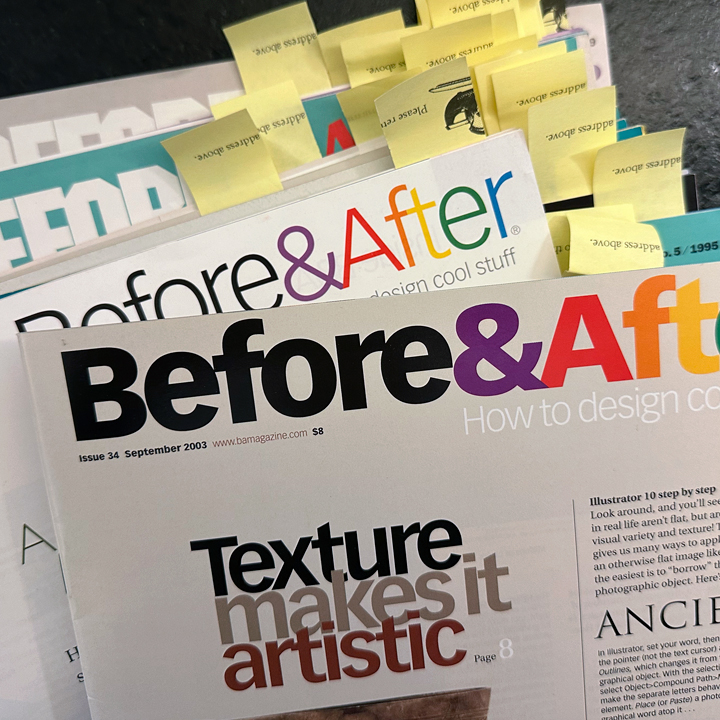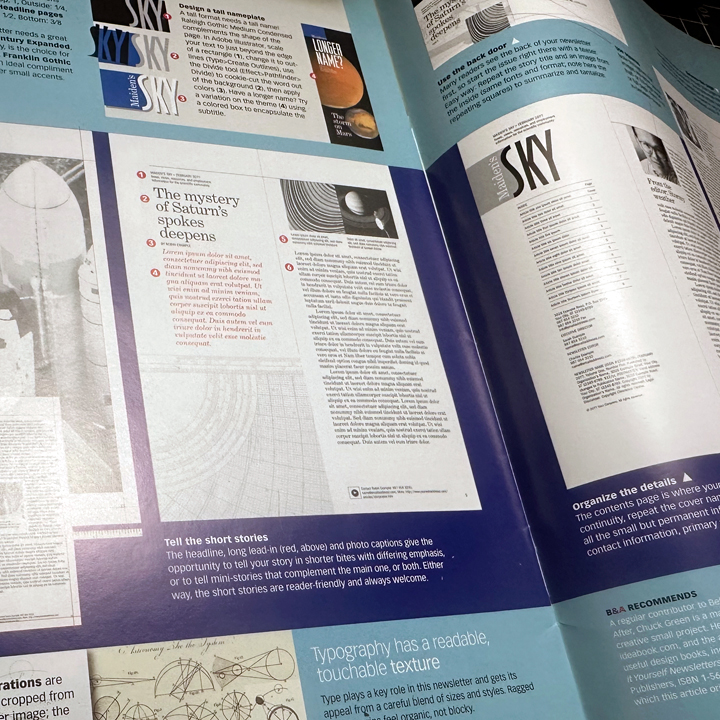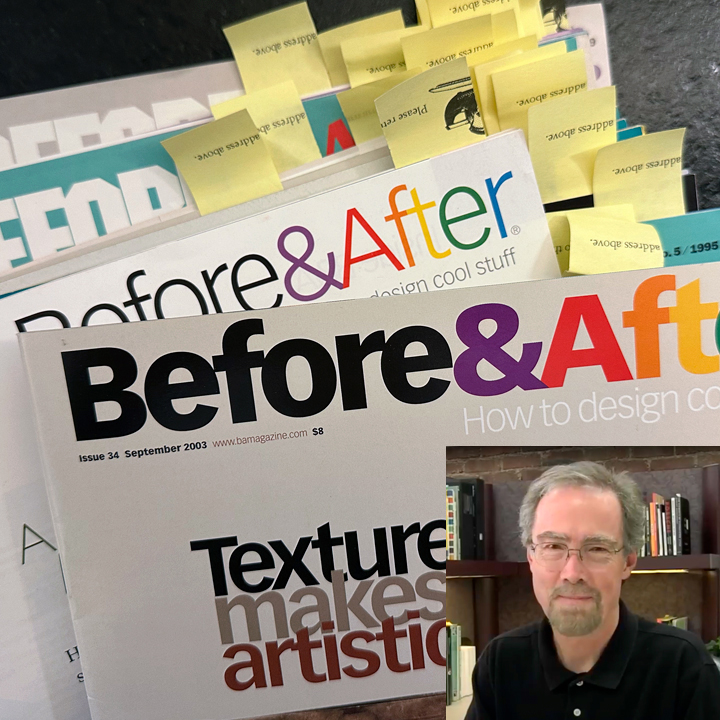John McWade, a true pioneer in desktop publishing and a gifted design educator, passed away on October 8, 2024, from complications following heart surgery. Here’s a small slice of his remarkable journey.
In the early 1970s, “art school” could be disappointing for those of us more interested in graphic design than pure artistic expression. So it was a somewhat disenchanted John McWade who went to work at a print shop in 1973 designing and pasting up the run-of-the-mill stuff that keeps the mill running: business cards, flyers, brochures, and more, using the traditional tools of the trade—a T-square, triangles, Rapidographs, typeset text, a waxer, and so on. It was a world that required craftsmanship, where every layout and letter was a labor of skill and precision.
Then, everything changed…
At the 1985 Seybold Conference in Los Angeles, John’s path crossed with that of Jeremy Jaech, chief engineer of a small Seattle startup called Aldus. He watched over Jeremy’s shoulder as he worked on a piece of software destined to revolutionize the industry: Aldus PageMaker. These were heady days of innovation—the dawn of the personal computer era, a technology poised to reshape individual lives and entire industries.
Just six months earlier, Steve Jobs had unveiled the Apple LaserWriter, the first computer printer to use Adobe’s PostScript page description language. That breakthrough—paired with PageMaker and the Macintosh—was set to transform the way pages were designed and printed. Soon, producing professional-quality text and images would no longer be the exclusive realm of systems costing hundreds of thousands of dollars and requiring teams of specialists to run.
This new technology would make such capabilities accessible, affordable, and, to John, utterly irresistible. As he would tell you, that meeting with Jaech changed his life.
“I flew home with Jeremy’s promise to send me a test copy, and told my boss I was quitting the best graphics job in Sacramento to start a new business—a desktop publishing business—by myself, relying on a program that did not yet exist. I was about to make pages and test software; it sounded to me like design and laboratory work, so I christened my microscopic company PageLab. It was the first desktop publishing business in the world.”
This wasn’t just a career pivot; it was a leap of faith. John was betting on a future that had barely taken shape. It’s easy to forget that, in those early days, the first Macintosh had only a 9-inch monochrome screen, and the Apple LaserWriter delivered just 300 dots per inch (dpi)—a far cry from the capabilities of today’s printers.
The tools were primitive, and many were quick to dismiss them. It seemed unthinkable that roles like designers, production artists, typesetters, and prepress technicians could be replaced by a small machine that fit on a desk. The notion that a single device could upend entire industries like advertising, publishing, and printing seemed absurd. Yet those who doubted its potential were wrong.
Fast forward to 1990
That year, John’s vision began to take form on a larger scale. In January, the first issue of the magazine he and his wife Gaye Anne would publish 20-plus years Before & After, rolled off the press. As he explained, the magazine was designed “to help the novice—the non-design professional—with graphic design.” It fulfilled that mission—and much more.
Its tagline perfectly captured the goal: How to design cool stuff. Many sought to occupy the same space—writers and designers of books and articles alike—but few could match John’s mastery: creating visually striking designs while clearly explaining the “how” and “why” they worked. He had an unparalleled understanding of process, layout, typography, technology, and marketing.

Study the pages of Before & After, and you’ll discover the wealth of precise details and subtle elements that make page design both fascinating and challenging. The magazine wasn’t just a resource, it became a touchstone for tens of thousands of non-designers and professionals alike who learned to make the complex simple, and the simple beautiful. It was a master class in visual communication.
John McWade’s contributions to the design profession are immeasurable. After Before & After, he became one of the most-watched presenters at the online education company Lynda.com, later acquired by LinkedIn in 2015. Through his video tutorials, his influence reached far beyond the magazine. A testament to the clarity and value of his work is that so much of it remains relevant today, these years later.
Before and after “Before & After”
I had the privilege of writing for John McWade after my Desktop Publisher’s Idea Book was published by Random House in 1993. My first project for him was something we called “Smart Art”—an extension of the kind of projects I had created for that book.
I’d send him a list of ideas, along with sketches, and he would choose those that sparked his imagination: projects such as “business card brochures”, “flying flyers”, and “message wraps”. Later, I contributed longer pieces like a “newsletter postcard” and a “plug-in catalog”.

Working with John was a unique experience. He had a gift—the ability to see what others don’t. He could spot details that elevated a project from good to great. If something didn’t work for him, he wouldn’t take over and redesign it; instead, he’d offer precise feedback, giving me suggestions on how to make it better. He had that rare ability to improve without taking away, to guide without controlling. It was a joy to collaborate with him.
But, in the end, what I treasure most was our friendship. We were born in the same year, our career paths ran parallel, we shared a deep obsession with the details and processes of design, and we are both Christians.
In recent years we’d spend a couple of hours on Zoom every few months, talking design, solving the problems of the world, and debating the deeper questions of life. It is those conversations that I will miss the most.
John now knows the secrets of the universe. His legacy is firmly rooted not only in the design industry he helped revolutionize but also in the hearts and minds of the countless people he touched.
A preview of one of John McWade’s design courses on LinkedIn Learning…
John’s story in his own words…
Word processing and desktop publishing were significant catalysts in popularizing personal computing. In May of 2017, the Computer History Museum in Mountain View, California, recorded the Desktop Publishing Pioneer Meeting—a gathering of some of the people who invented or participated in the development of desktop publishing, from the 1960s to the 1990s. If you’re curious about those times, I recommend the series highly. (Day 1 focuses on the technology and day 2 looks at the business side.)
Posted in October 2024 / Chuck Green is designer, a contributor to numerous magazines and websites, and the author of books published by Random House, Peachpit Press, and Rockport Publishers. All rights reserved. Copyright 2007-2024 Chuck Green. Contact.




Thanks so much, Chuck. I didn’t realize John had passed. RIP. I didn’t know he was a Christian either, but I look forward to meeting him.
John McWade was my hero. Virtually everything I knew about computer design from 1990 on was learned from him and his fantastic Before and After magazine (I still have a stack of them). He turned my boring cut-and-paste job into an exciting adventure in making words beautiful. I am sad to hear of his passing and thank David Airey for the news and for linking this wonderful article, which I enjoyed reading almost as much as I enjoyed each issue of Before and After. RIP John, you really did change the publishing world.
I used to read Before and After religiously, even when it went digital. I also used to chat with John over the years and he was always gracious. He contributed much to the creative and graphic design community. I’m saddened that he is gone.
John became one of my “kids” when he was about 12 years old. I remember when he first approached his moth with a book of matches that said something like “can you draw this” and offered free drawing lessons. His mother and my wife were great friends and John ever lived with us for a time.. That is when John first began his journey into “Art” and eventually into publishing. Later in early 80’s he helped this Old Man, in his late 40’s at the time, jump into the modern age and changed the way he worked.
Chuck, this is such distressing news! I am so very sorry that you have lost such a dear friend, and I am sorry that we have all lost such an inspiring teacher. I have every single copy of Before&After, and you can open any copy at any page, and it is all still relevant today. I was exactly John’s audience: the curious non-professional, a graphic-design groupie. He was brilliant. (One of my great losses in retiring from MIT was losing free access to Lynda.com and John’s tutorials.) A great loss. And thank you for this lovely remembrance of him.
How very sad! He was a brilliant teacher and practitioner of graphic design. I made a great living working in ad agencies and thought I knew a lot about the business until I subscribed to John’s “Before & After,” simply excellent newsletters, his books, and corresponded with him. He helped me simplify my style, be brave with color, and understand pagination!
May he be at peace.